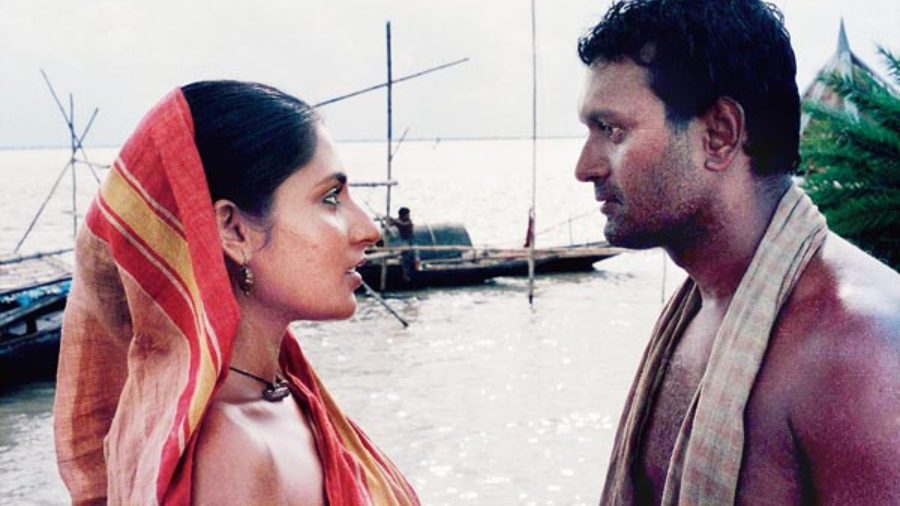Adapated from the masterful Manik Bandopadhyay novel, Goutam Ghose’s Padma Nadir Majhi (1993) takes the classic Bengali text of the same name and spins a stark web around it. Padma Nadir Majhi as a text is vast yet specific, diabolically internal even when it is moving from one space to another. Ghose’s film adaptation faithfully follows the same textual pattern with immense gusto and skill. Set in the fictional town of Ketupur in Bangladesh, just before the Partition of India, it revolves around the fisherman Kuber (Raisul Islam Asad), who lives with his crippled wife Mala (Champa) along with son Lakha and soon-to-be-married daughter Chandi. Their livelihood is entirely dependent on the Padma river — if the river permits, Kuber comes home with hilsa and on other days of unforseen turbulence the only way out is starvation for the entire clan.
Ghose, who also shares credits for cinematography and music (along with Alauddin Ali), establishes the setting with a lot of detail. We get a glimpse of the boatmen during their work, singing melancholic songs of love and separation, and their return home, the circumstances, insecurities and uncertainties laid bare with unhurried sequences of the boatmen discussing their day and planning for the next. Kuber, along with the other families in the surroundings, lives in a close-knit community where the vagaries of living on a land surrounded by the river has touched one and all. Kuber’s personal and professional life is shaken by the introduction of two human figures — his sister-in-law Kapila (Roopa Ganguly) and the conniving businessman Hossain Miyan (Utpal Dutt).
Kapila has come to be of help to her sister Mala, after having eloped from her own house, leaving her husband. Here, her lively and quietly flirtatious nature presents itself as a stark contrast to that of her disabled sister. Away from home, Kuber befriends the enigmatic Hossain Miyan, whose wealth and capital mystifies everyone. He comes to know that Hossain Miyan is setting up his own utopia of sorts, an island which he calls Moynadweep. In Moynadweep, resettlement is increasing since there are no divisions among class and caste, and the people live there by clearing the forest and using it for cultivation.Yet there are some people who have returned from Moynadweep who have a completely different story to tell.
Then there are the storms that threaten their lives altogether. There is a stunning, utterly unforgettable sequence when a storm arrives like a merciless force of nature and shatters everything on its way. The lights go off, the huts are broken and in the pitch-dark interiors of their homes, the frightened women blow conch shells. It is a nightmarish situation, hauntingly choreographed and edited. The dirt and the decay of the landscape are gritty and real, and yet Padma Nadir Majhi also creates a striking visual mindscape to escape into. When Kuber visits the sinister Moynadweep for the first time, it is like a dream — he hasn’t seen any land like that before. The allure draws him in, and Kuber’s destiny lies in whether he will be able to control his instincts or not.
In this deceptive mix of mystery and intrigue, Moynadweep becomes the metaphor for escape from the hardships of their routine work. The men who know talk about it. The women are far less capable of grasping what the men of the house are thinking. Mala complains to her husband that the roof of their house has been leaking, yet nothing is done. She has no choice but to put a bowl as a temporary solution. Chandi’s prospects of marriage are paused when she sprains and hurts her leg. Who will marry a girl with a limp? These women are seldom allowed to get out of their houses. When Mala defies that one rule to bring her injured daughter back from the hospital, Kuber becomes furious and unspools all his building anger on her. Kapila’s directness about her desires, although ambiguous to the rest, is clear as light to Kuber. She is an indirect threat to the stability in his personal life that is important for Kuber to function professionally.
Powered by nuanced performances, Padma Nadir Majhi is a towering piece of cinema, one that invites its viewers into the minds and bodies of these disproportionately poor lot of people and asks if you can see the difference. Kuber tells his wife, “Padda amago joto daay abar totoi loy” (the Padma river gives as much as it takes.) Nature here is a chain that connects the quagmire dots of human passions and actions, which are as powerful as those waves of the river that define the livelihood of Kuber and his family. Ultimately, more than the river itself, it is Kuber who succumbs to his amorous natural instincts that leaves behind a trail of destruction.
